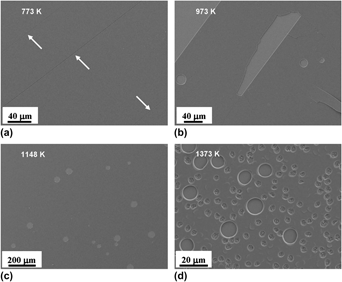Article contents
Thermally induced damages of PECVD SiNx thin films
Published online by Cambridge University Press: 25 August 2011
Abstract

This study investigates thermally induced structural damages to amorphous plasma-enhanced chemical vapor deposition (PECVD) SiNx thin films at elevated temperatures, including chemical structure, microstructure, and physical integrity. The films were synthesized by means of PECVD method. Heating to elevated temperatures in air was found to cause multiple forms of chemical, structural, and physical damages. Chemically the films were found to oxidize and lose their nitrogen and hydrogen contents. Structurally the amorphous SiNx matrix was found to convert partially into SiO2 as a result of oxidation and to crystallize into Si3N4 crystallites. The physical damages include pinholes, circular “penny” cracks, random “dry mud” cracks, and spalling. The types of the damages were observed in different temperature regimes. The formation of the penny cracks is attributed to excessive compressive stresses created in the film by oxidation, which is associated with a large volume expansion. The formation of the random cracks is attributed to tensile stresses caused by crystallization, which is associated with a large volume contraction. Such damages limit the suitable application conditions for devices made of these films.
- Type
- Articles
- Information
- Copyright
- Copyright © Materials Research Society 2011
References
REFERENCES
- 6
- Cited by


